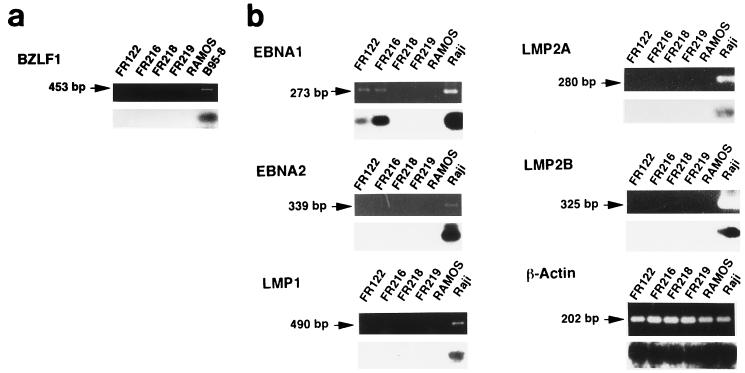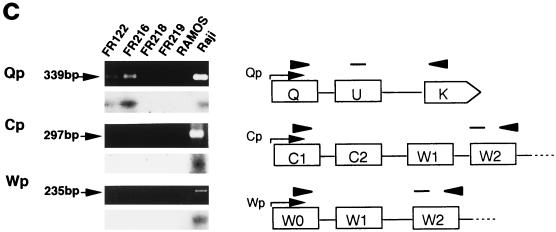FIG. 3.
RT-PCR analysis of BZLF1 gene and EBV latency gene mRNAs in human EBVaGC in SCID mice. Transcripts of the BZLF1 gene (a) and the EBNA1, EBNA2, LMP1, LMP2A, and LMP2B genes (b) of EBV were amplified by RT-PCR, electrophoresed, and visualized with ethidium bromide staining (upper panel), and each blot was then hybridized with a specific internal probe (lower panel). (a) Neither the original EBVaGC (FR122) nor the KT tumor (FR216) show BZLF1 transcript, whereas B95-8, an EBV-producing cell line, does. (b) Among the EBV latency genes, both the original EBVaGC (FR122) and the KT tumor (FR216) show EBNA1 transcript but not EBNA2, LMP1, LMP2A, or LMP2B transcript. All of the transcripts of the EBV latency genes examined were seen in an EBV-containing lymphoma cell line (Raji), whereas none were observed in a lymphoma cell line that is negative for EBV (Ramos) or in mouse tissues (FR218, liver; and FR219, kidney). β-Actin mRNA was readily amplified from all of the tissues tested. (c) Promoter usage of EBNA1 mRNA in human EBVaGC in SCID mice. Three promoters of EBV DNA, Cp, Wp, and Qp, are mutually exclusive for the expression of EBNA1. Each promoter pair and the corresponding exon was amplified by RT-PCR, as illustrated. Both the original EBVaGC (FR122) and the KT tumor (FR216) show Qp-driven EBNA mRNA but not Cp- or Wp-driven transcript. The latter two EBNA1 transcripts are demonstrated in an EBV-containing lymphoma cell line (Raji). None of the transcripts are amplified in a lymphoma cell line that is negative for EBV (Ramos) or in mouse tissues.


